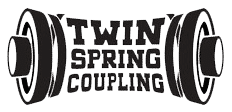Coupling technology to replace Elastomeric couplings.
Twin Spring Coupling features include.
- Speeds: Up to 7000 rpm.
- Nominal Torque 150 ft lbs – 500ft lbs (203 – 678Nm).
- Standard Coupling sizes 1/2″ to 1 3/4” (12.7-46mm).
- Temperature: -20° to +290°F , (-4° to +140°C).
- Connection: Spline, Keyway, Square/Hex.
- Dual Springs absorb vibration.
- Torsionally rigid design at angles less than 10°.
- Minimal backlash.
- No moving parts.
- No parts made from polymer or rubber so no degradation due to heat, UV radiation or compression.
The elastomeric coupling has been an industry standard for a number of years for motion control, for engineers looking for a flexible coupling solution for high speed minimal misalignment applications.
Industries that have the need for vibration control or work environments what contain moisture have traditionally used elastomeric couplings.
The downside is it only able to handle angles between 1/2° and 2° and the ability to handle torque is minimal.
The Twin Spring coupling dual spring design allows for minimal windup, non-balanced maintenance free, flexible shaft coupling solution with the positives of increased torque capacity and increased flexibility even at speed which ideal for motion control for servo motors, conveyors, pumps etc.
This means where applications that need increased torque and misalignment while still working at high speed can now be achieved without resorting to a jaw or elastomeric coupling (which still cannot work at increased angle misalignment).
The Twin Spring coupling contains no internal components that require maintenance so we offer the positives of increased torque and misalignment in one coupling without the worry of maintenance.
At low angle misalignment, Twin Spring coupling maintains its torsional rigidity and continues to do so as misalignment continues to increase due to the pivoting central ball bearing which allows torque to transfer through the coupling.
Lets break down each coupling type.
Jaw Couplings.
Jaw couplings are different to universal joints as they are made up of 3 pieces, 2 hubs “jaws” and either a polyurethane, Rubber, Hytrel or bronze “hub” in the center. While the Jaw coupling can also run at high speeds it can can only work at 2 degrees misalignment before the center hub starts to wear.
The Jaw coupling can only handle small amounts of torque as well.
The jaw coupling is what’s called a safety coupling, which means if the center hub fails the jaws clamp together and it can continue to function but without the hub to reduce vibration it will start to damage machinery components unless replaced.
Elastomeric Insert.
Elastomeric insert couplings are a scaled up version of a jaw coupling, bigger hubs and a bigger insert. The larger size allows for applications where minimal variation of alignment is the standard, the angle of misalignment is low usually less than 1°.
These insert couplings offer vibration absorption, low torque output as not to crush the insert much like that of a jaw coupling and again very low angles of misalignment.
Usually these couplings are used in industries where moisture and dust are present, environments that would very quickly shorten the life of a universal joint.
Tire Coupling.
Tire/Tyre couplings are very similar to the elastomeric insert coupling but in this case it is a round coupling offers absorption of vibration, some angular misalignment (less than 1°) and float. The same applies with these coupling to the insert types (since they are basically the same principle just executed differently).
Usually made from rubber or a polymer it will decay over time and much more quickly if the angle of misalignment s over 1°.
Donut Coupling.
A coupling resembling a doughnut with 6 bolt holes to allow 3 to bolt to one hub the other 3 to the other hub. Angle of misalignment (Less than 1°) High torque at largest size but like any other elastomeric coupling, fails due to insert compression and wear if used outside of the 4° limit.
Twin Spring Coupling offers a no insert solution, vibration is absorbed by the dual spring design, no internal components so can be used in environments that have moisture, dust etc without needing constant maintenance like a u-joint and its bearings.
Capable of 7000 rpm, flexible to 45° and nominal torque of 6000 in lbs.
Replaces.
Ruland – JC jaw , MJC jaw series.
Guardian Coupling – 28/38, 38/45, 42/55, 48/60 series, LJW110-LJW225.
TB Woods – L090, L100, AL100, SS100, L110, AL110, SS110, L150, AL150, SS150, L190, L225, L276 series, Sureflex WE5,WE10, WE20, WE30, WE40.
Lovejoy – C276 (SOX) CJ 48/60 42/55, CJ38/45, CJ28/38 series, Saga S13, Saga S15, Saga S18, S Flex Size 6-12, Delta Flex 40/40HT, 50, 50HT/60.
R+W America – EK series.
Tsubaki – L099, L100, L110, L150, L190, L225, L110A series.
Boston Gear – FC25, FC30, FC38, FC45 series (XFCBB, XFCR, XFCA Inserts).
KTR – Rotex AL-H 28,38,42,45,48 GJL 38, 42,48,55, 65 series.
Rexnord – Omega E10, E20, E30, E40, Omega HDY 5, HDY10, HDY20, HDY30, Viva V130-215, Falk Wrapflex 10R, 20R, 30R.
SKF- FRC 110, SKF F50, F60, F70, F80.
